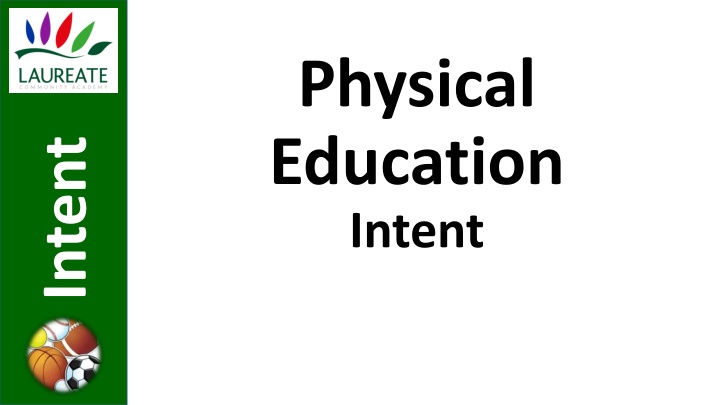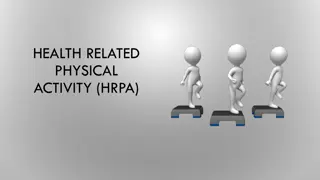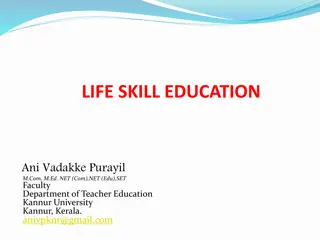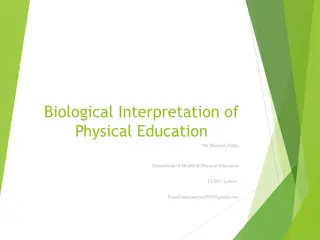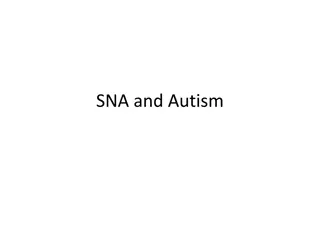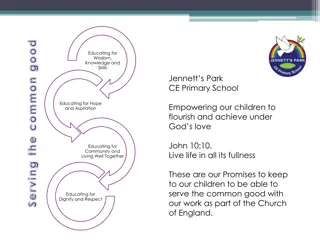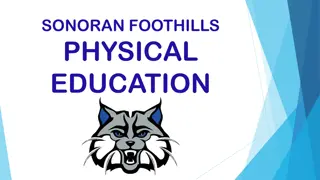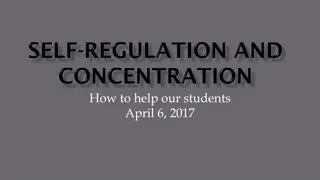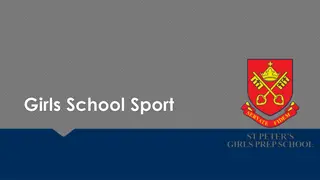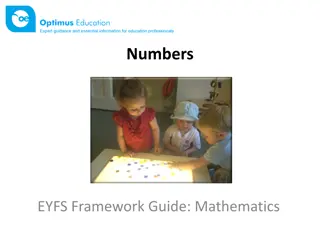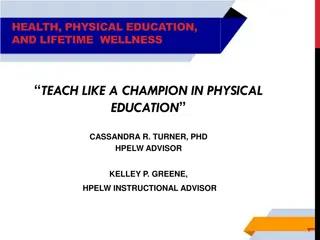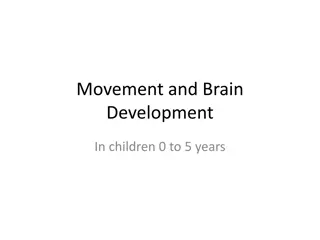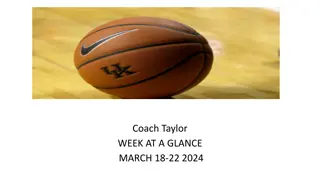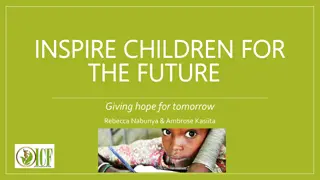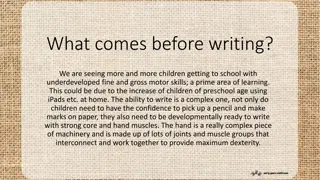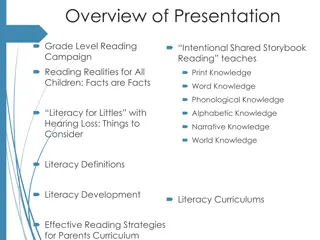Importance of Physical Education in Developing Children's Skills
Physical Education (PE) plays a crucial role in children's overall development by promoting physical fitness, teamwork, confidence, and cognitive functions. PE helps children build fundamental motor skills, embrace a healthy lifestyle, and learn essential values like fair play and sportsmanship. Through a balanced curriculum, children are encouraged to excel in various physical activities, fostering a lifelong passion for sports and physical well-being.
Uploaded on Mar 05, 2025 | 0 Views
Download Presentation

Please find below an Image/Link to download the presentation.
The content on the website is provided AS IS for your information and personal use only. It may not be sold, licensed, or shared on other websites without obtaining consent from the author.If you encounter any issues during the download, it is possible that the publisher has removed the file from their server.
You are allowed to download the files provided on this website for personal or commercial use, subject to the condition that they are used lawfully. All files are the property of their respective owners.
The content on the website is provided AS IS for your information and personal use only. It may not be sold, licensed, or shared on other websites without obtaining consent from the author.
E N D
Presentation Transcript
Physical Education Intent Intent
PE Why is PE important? Intent At Laureate Community Academy, Physical Education is an integral part of our curriculum that is inclusive and engages all pupils. We want children to be inspired and develop a lifelong passion for Sport and Physical Activity. Children develop the knowledge, skills, and competence to excel in a broad range of sports and physical activities. We aim to deliver high-quality teaching and learning opportunities that enables all children to achieve their personal best.
Why is PE important? Children learn to appreciate the significance of exercising for a lifetime. Consistent, physical activity is the best way for us to eradicate obesity and sustain a suitable body weight. . Children learn the fundamental motor skills that will allow them to develop the physical capability that in turn will produce confidence and leads to safe and successful involvement in a wide range of sports. Intent Children are encouraged to increase their fitness levels during PE including muscular and cardiovascular endurance, strength and flexibility. Children can learn valuable lessons about accepting responsibility for their individual development leading to greater self-discipline. PE gives chances for children to be creative, cooperative and competitive and to face up to diverse challenges both as individuals and in groups. Physical activity helps ease anxiety, tension and stress and will result in improved attention in class. Movement can be used to strengthen the understanding of several subjects taught in the classroom e.g. mathematics. Movement has also been shown to heighten the function of our brain. Many activities taught in PE require children to work in groups to solve problems. These opportunities are outstanding for learning both leadership and teamwork. Children learn to develop the concept of fair play, honest competition, good sportsmanship and how to handle both success and defeat. All this links to our values REACH. Where we aim for children to Respect, Enjoy, Aspire, Communicate and be Healthy.
PE Aims of the PE Curriculum The national curriculum for physical education aims to ensure that all pupils: Intent develop competence to excel in a broad range of physical activities are physically active for sustained periods of time engage in competitive sports and activities lead healthy, active lives. (The National Curriculum, 2014)
PE Key Stage 1: National Curriculum (KS1) Key stage 1 children should develop fundamental movement skills, become increasingly competent and confident and access a broad range of opportunities to extend their agility, balance and coordination, individually and with others. They should be able to engage in competitive (both against self and against others) and co-operative physical activities, in a range of increasingly challenging situations. Children should be taught to: master basic movements including running, jumping, throwing and catching, as well as developing balance, agility and co-ordination, and begin to apply these in a range of activities participate in team games, developing simple tactics for attacking and defending perform dances using simple movement patterns Intent
PE Key Stage 2: National Curriculum (KS2) Pupils should continue to apply and develop a broader range of skills, learning how to use them in different ways and to link them to make actions and sequences of movement. They should enjoy communicating, collaborating and competing with each other. They should develop an understanding of how to improve in different physical activities and sports and learn how to evaluate and recognise their own success. Pupils should be taught to: use running, jumping, throwing and catching in isolation and in combination play competitive games, modified where appropriate [for example, badminton, basketball, cricket, football, hockey, netball, rounders and tennis], and apply basic principles suitable for attacking and defending develop flexibility, strength, technique, control and balance [for example, through athletics and gymnastics] perform dances using a range of movement patterns take part in outdoor and adventurous activity challenges both individually and within a team compare their performances with previous ones and demonstrate improvement to achieve their personal best. Intent
EYFS The most relevant Early Years outcomes for PE are taken from the following areas of learning: Intent Physical Development Expressive Arts and Design
Cross Curricular Links Physical Education provides opportunities for pupils to develop the key skills of: Intent Communication and teamwork Music and Dance PSHE Science Math Geography
PE Implementation Implementation
Implementation . Children participate in high-quality PE lessons timetabled for 2 hours a week covering two different sports/skills per term. Teachers use and adapt, Striver and other P.E specific resources such as LTA school youth tennis scheme for planning lesson content and to ensure lessons across years show progression and all aspects of the National Curriculum are met. Classes follow the PE long term plan to ensure children participate in a variety of sports and games with progression through the year groups. Early Years children are taught physical development within the Early Years Framework Key Stage 1 children are taught a range of fundamental skills to develop agility, balance, and coordination Key Stage 2 children play modified competitive games and apply and develop a broader range of skills as well as learning how to evaluate and recognise their own success. Key Stage 2 residential trips provide extra outdoor and adventurous activities and team building skills for their well-being and enhance social and independent skills. Children attend swimming lessons in year groups at the local swimming pool to meet the aim of the national curriculum guidelines of every pupil who can swim at least 25m by the time they leave year 6 and achieve the personal water safety award. Implementation
Extra Curricular Opportunities We invite pupils to attend and to participate in extracurricular activities that are inclusive, enjoyable and increase children s physical activity. Sports clubs are offered to KS1 and KS2 children. External sport coaches provide extracurricular activities such as football, dance, netball hockey and basketball. We run clubs that are free of charge to make sure every child can take part in clubs out of school hours. We have two play leaders employed at lunchtime to ensure children are developing a range of basic skills such as aiming, catching and skipping. Annual whole-school Sports days highlight the skills the children have acquired during the year Implementation
Extra Curricular Opportunities Continued: Competitions between house teams and year groups and inter school competitions through Forest Heath Suffolk Schools Partnership All children participate in the daily mile for at least 15 minutes every day. Sport Premium money is used to provide additional equipment for break time/lunch time Sports leaders from years 5 and 6 promote activity and clubs and provide pupil voice at meetings with staff. Implementation
Content and Sequence EYFS PE Implementation EYFS PE follows the Striver units. Each half term, they have a different focus around their physical development and expressive arts and design.
Content and Sequence EYFS CUSP Foundations Unit Autumn 2 Physical Development Autumn 2 will focus on the CUSP Foundations unit and allow them to express physical development and expressive art and design. Implementation
PE in EYFS Intent Physical Development and Expressive Arts and Design.
Long Term Plan showing content and sequence for the rest of the school. Implementation
Planning: An example plan year 4 dance Implementation
Planning: An example plan year 4 dance Implementation
Planning: An example plan year 4 dance Implementation Links to see a video or image demonstration of movement
Metacognition in PE Activate prior knowledge Recap prior learning within that block of activity. Discussion of previous techniques Recap of sport specific vocabulary Discussion of role models within that sport. Explicit strategy instruction What skill are we focusing on today. What are we aiming to achieve by the end of the session. How does this fit into the progression of the unit Modelling of learned strategy Demonstration of technique (either teacher or student led with verbal dictation). Using videos or technology to aid modelling difficult techniques. Using thinking out loud to demonstrate specific requirements of that technique Memorisation of learned strategy Through practice, explore the technique and apply their understanding. Questioning of reason for movements/actions. Guided practice Guide students in their exploration and aid with adapting techniques for the movement/action. Model to be repeated if necessary. Independent practice Children to practice and explore the different techniques with the scaffolded focuses. Structured reflection Implementation
Worked example (Year 5 Hockey) Activate prior knowledge Teacher discuss the key parts of the prior learning (previous experience of that sport/movement) and key techniques needed in a hockey session, e.g. discussing dribbling. Explicit strategy instruction The teacher explains how the lesson's focus links to the aim of successfully playing hockey. Questioning of what techniques are needed (e.g. appropriate hold of the stick and correct body position for dribbling). Modelling of learned strategy Two-way question and answer to recall previous knowledge and ensure technique is correct. Teacher or student demonstrates whilst the teacher or class dictates the necessary requirements. Memorisation of learned strategy Students demonstrate the stance needed and how to hold the stick to show understanding of technique Guided practice Exploring the technique with movement. Teacher to help students with technique to ensure correct application Independent practice Applying technique in practice drills and eventually controlled small sided games. Implementation
Tailoring for SEND We plan for the first 20% and scaffold the lesson and tasks to meet their needs. Then we remove the scaffolding, as appropriate, to meet the needs of other pupils. Implementation We aim to provide all children with the opportunity to confidently progress in their physical and sport education. We strive for all children to access the PE curriculum equally, but this can vary in how it looks depending on individual's needs. The Striver has a strong focus on adapting the aims of the lesson to suit the individual needs. This is deliberately planned to ensure they can access the work. The main adaptions are focused on the space used, the equipment, the task.
Tailoring for SEND continued Some pupils may have specific advice and guidance in their EHCP, and / or may have a risk assessment which all adults need to be aware of. Some pupils may require individual task boards to enable them to follow a series of steps where a task has been broken down into smaller, more manageable chunks. Implementation Some pupils may have a hearing impairment. Teachers should think carefully about how this impacts their ability to hear and produce sounds and consider how best to adapt the PE lessons to ensure these pupils can be successful. This may be adapting lessons to be in a different environment to reduce the overload on hearing. Also, this may include using visual aids, pre-teaching of instructions and targeted adult proximity / support. Some pupils may have a visual impairment. This may impact their ability to see demonstrations or to work with partners at a distance. Teachers should think carefully about how they can adapt these lessons, considering proximity, adapted equipment (coloured or with noises). Giving the student a smaller space to work in may be appropriate.
Tailoring for SEND continued Some pupils may have sensory difficulties. This may require adapting the size or texture of the equipment used. Also, this may require the adaption of their kit (e.g. wearing gloves, wearing a non-collared top etc.). If it is an activity which requires the removal of shoes (e.g. dance or gymnastics), adjustments could be made to ensure they are able to access the activity (for example wearing shoes and having a wider space to ensure the safety of others). This will ensure they are still able to access the learning. If it was for a medical reason, working within a set space may be possible. Implementation Some pupils may have physical impairments. Depending on their impairment, minor to major adaptations may be required. This may be adapting equipment, the activity or the adult support. It is dependent on the physical disability so research into the adaptations would be required on an individual case. Some pupils may have difficulties with attention. Individuals may require breaks or opportunities to achieve a small task (e.g. in a basketball lesson, go and get three shots in the hop and then come back) For some pupils who have specific challenges around processing, some of the lessons may require adaptation to ensure that all pupils can participate fully in the lesson. This may mean reducing the number of instructions or steps in a task or shadowing another child.
Continuous Professional Development Implementation PE Lead attends courses and Forest Heath meetings. Staff completed a skills audit and courses have run to support their learning. In the 2021/2022 year training has covered COJO, Athletics and Gymnastics.
Physical Impact Education Impact
At Laureate Community Academy, we ensure that our PE curriculum is progressive and allows children to develop fundamental skills and apply them to a variety of sports and activities. All children are provided with the skills and given opportunities to demonstrate improvement to achieve their personal best. Our pupils are physically active, and this has positive implications for their well-being and learning in the classroom. Children understand how to lead a healthy lifestyle and understand the importance of exercise. All pupils understand the values and importance of fair play and being a good sportsperson. The PE curriculum helps children become confident to take initiative, lead activities and encourage them to become lifelong participants in sport and games. Impact
How do we measure the impact of PE teaching? Subject Leaders use evaluation spider diagrams, monitoring matrix and learning walks throughout the year. Impact
Teacher assessment Whole Class Assessment Sheets are throughout every lesson to ensure children are achieving the intended learning outcomes. Teachers are responsive to any needs identified and use this knowledge throughout the planning and assessment cycle. At the end of the unit teachers will use the Whole Class Assessment Sheets to secure a summative judgement for each child. Subject leaders will lead pupil conferencing and will also complete data analysis of Whole Class Assessment Sheets to monitor progress and identify next steps with the PE curriculum. Impact
Our PE curriculum has been awarded the Platinum games mark. Impact
